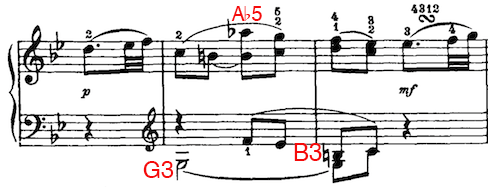Integrated Music Theory 2023-24
Discussion 1a - Pitches and Clefs
Clef Chatter
“What instruments use alto clef?”
- Viola, Cello, Trombone, and old Alto choral parts
“What instruments use tenor clef?”
- Cello, Bass, French Horn, Trombone, Euphonium, Tuba, and old Tenor choral parts
“How can we remember where middle C is on each clef”
- Treble clef: one ledger line below the staff
- Alto and Tenor clef: between the curls on the clef symbol
- Bass clef: one ledger line above the staff (opposite of Treble clef)
“What strategies can we use to understand Alto and Tenor Clef?”
- Alto is just below treble clef and just above the bass clef. If you think of treble and bass clef together, alto clef is the notes in the middle that bridge the gap between treble and bass clef
- Treble clef is visually a seventh higher from alto clef, not a second away
- Think of the lines of the alto clef as an F major 9 chord (F,A,C,E,G)
- Everything that is usually on a space is on a line. Create a visual transposition. Think of Alto clef as being a second away, then think down an octave
- Using reference intervals to connect two clefs
- Relating the strings of an instrument to the visual difference between clefs
- Knowing where middle C is
- Sean’s way - Because the alto clef looks to be lower than tenor clef, you read as if it is an interval of a second higher compared to treble clef. Because the Tenor clef looks to be higher than alto clef, you read as if it is a second lower compared to treble clef.
Quintessential Quotes
“The point of these first four weeks is to learn how to communicate the fundamentals that we already know to those who are not aquainted with them. We take for granted that we have been learning this for years. Sometimes, we will have to describe music to those who have no background. We have to make it understandable, as well as to do our best to keep it interesting.”
“Tenor clef sucks.”
Random Rattle
“How would you define rhythm?”
- The pattern of sound and silence measured over the course of time
Further Reading
======
From Open Music Theory
Notes
When written on a staff, a note indicates a pitch and rhythmic value. The notation consists of a notehead (either empty or filled in), and optionally can include a stem, beam, dot, or flag.

Staff
Notes can’t convey their pitch information without being placed on a staff. A staff consists of five horizontal lines, evenly spaced. The plural of staff is staves.
Clefs
Notes still can’t convey their pitch information if the staff doesn’t include a clef. A clef indicates which pitches are assigned to the lines and spaces on a staff. The two most commonly used clefs are the treble and bass clef; others that you’ll see relatively frequently are alto and tenor clef.
Grand staff
The grand staff consists of two staves, one that uses a treble clef, and one that uses a bass clef. The staves are connected by a curly brace. Grand staves are used frequently for notating piano music and other polyphonic instruments.
Ledger lines
When the music’s range exceeds what can be written on the staff, extra lines are drawn so that we can still clearly read the pitch. These extra lines are called ledger lines. In the example below, From Haydn’s Piano Sonata in G (Hob. XVI: 39), A-flat5 occurs just above the treble staff in the right hand, and G3 and B3 occur just below the treble staff in the left hand.

Accidentals
Accidentals are used to indicate when a pitch has been raised or lowered. They are written to the left of the pitch.
- When you lower one of the white notes of the piano by a semitone, you add a flat.
- When you raise one of the white notes of the piano by a semitone, you add a sharp.
- When you raise a note that is already flat by a semitone, you add a natural.
- When you lower a note that is already flat by a semitone, you add a double flat.
- When you raise a note that is already sharp by a semitone, you add a double sharp.
The example below shows the symbols for flat, natural, sharp, double sharp, and double flat, respectively.

